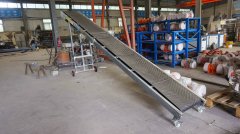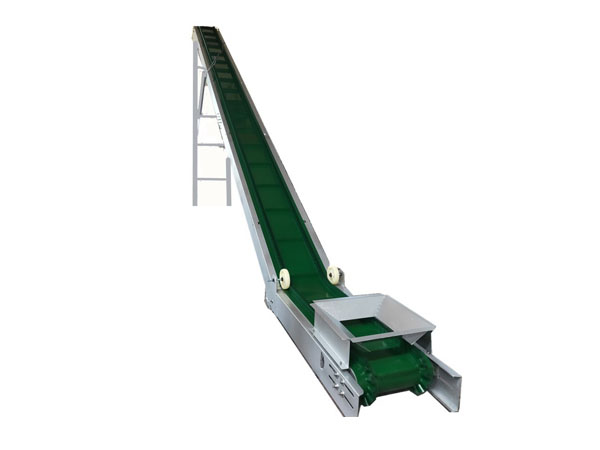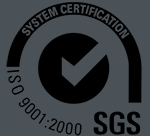Inclined belt conveyor
What is Inclined belt conveyor?
Inclined belt conveyors are used to transport materials from low to high locations. Based on their inclination angle, they can be broadly categorized into three types: low-angle (0-20 degrees), medium-angle (20-35 degrees), and high-angle (over 35 degrees). Their handling capacity and conveying distance can be adjusted based on the specific model and design parameters. For example, some models can convey distances of up to hundreds of meters, while handling capacity ranges from tens to thousands of tons per hour, depending on the width of the conveyor belt, speed, and material density and particle size. This design adapts to a wide range of materials and site conditions, making it a fundamental tool in the material conveying process.
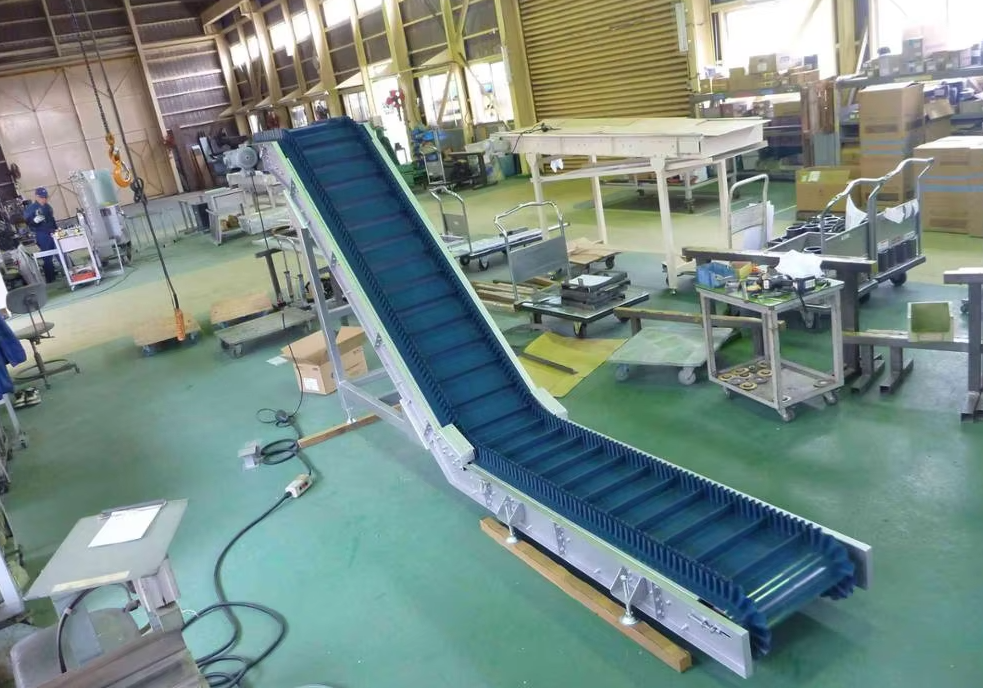
What are the types of inclined belt conveyors?
Inclined belt conveyors are widely used for conveying materials vertically or at an angle. They are categorized primarily by their inclination angle and belt structure. Different inclination angles determine their conveying capacity and applicable material range. The following are the main types:
Low-angle belt conveyors (angle ≤ 20°)
This type of conveyor uses either flat or trough belts. Due to the small inclination angle, materials are less likely to slide under gravity, thus requiring relatively low friction from the conveyor belt.
Technical Parameters: The inclination angle generally ranges from 0° to 20°. Parameters such as conveyor belt width, belt speed, and conveying capacity are similar to those of ordinary horizontal belt conveyors.
Features: Widely applicable, capable of conveying a variety of bulk materials such as coal, ore, sand, and grain. Simple structure, easy maintenance, and low cost. High conveying capacity: While ensuring the inclination angle does not exceed the specified limit, continuous high-volume conveying is possible. High efficiency: Due to the small inclination angle, material flow is smooth.
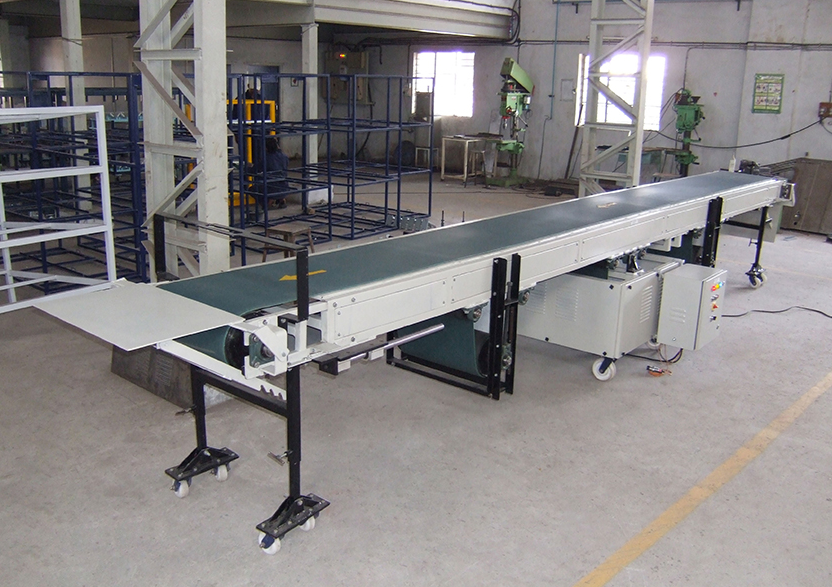
Medium-angle Belt Conveyor (20° - 35°)
When the inclination angle exceeds 20°, materials conveyed on ordinary flat belts tend to slide. To address this issue, medium-angle conveyors typically use patterned belts, such as herringbone, herringbone, and grid patterns, to increase friction between the material and the conveyor belt. Technical Parameters: Inclined angles typically range from 20° to 35°, depending on the material's angle of repose (the natural inclination of the material when it is stacked). The depth and spacing of the belt's pattern are key parameters.
Features: Highly adaptable to materials, suitable for conveying granular and bulky materials, effectively preventing them from sliding down. They have a small footprint and can achieve the same lifting height in a shorter length compared to low-angle conveyors, saving space. Regarding maintenance, patterned belts are slightly more expensive and more complex to clean than ordinary flat belts.
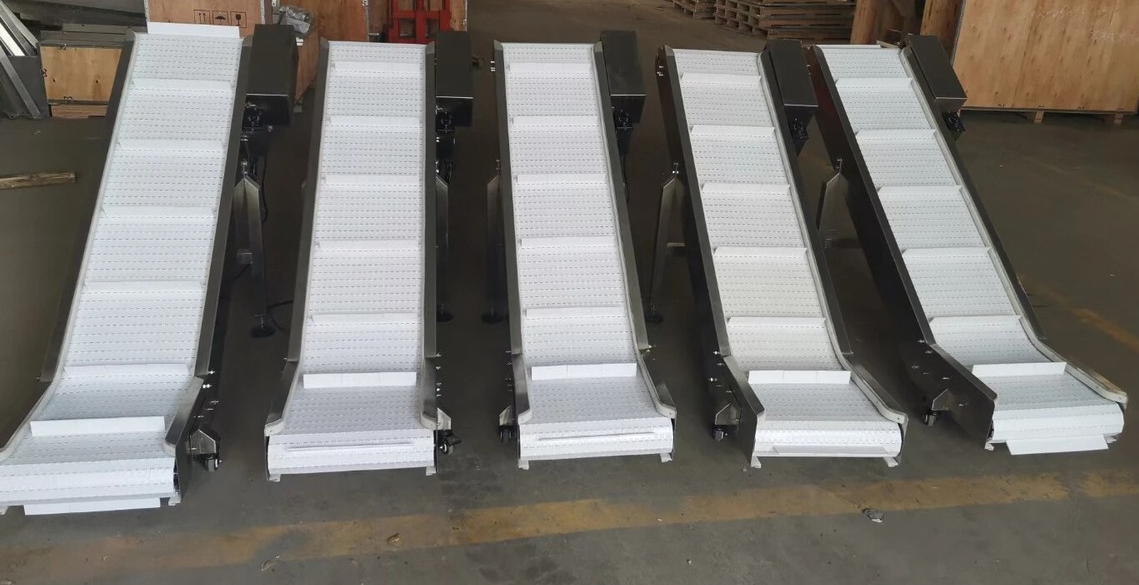
High-Angle Belt Conveyors (Angles > 35°)
To achieve near-vertical material lifting, high-angle conveyors utilize specialized belt structures, such as sidewalls and skirts. These belts feature corrugated "skirts" on both sides and internal "partitions," creating a closed pocket for the material, enabling large-angle and even vertical conveying.
Technical Parameters: Inclined angles can reach 90°, with the height and spacing of the skirts and partitions on both sides of the belt being key parameters. Features: High space utilization, capable of conveying materials vertically or at high angles, saving floor space. No material spillage: The skirt and partitions create a closed space, preventing material spillage. A single unit boasts a high lifting height, enabling high lift heights within a short conveying distance. Material requirements: It is primarily suitable for conveying bulk, granular, and powdered materials, but there are certain restrictions on material viscosity and particle size. The complex structure, including the conveyor belt and equipment, results in higher costs and is relatively difficult to maintain.
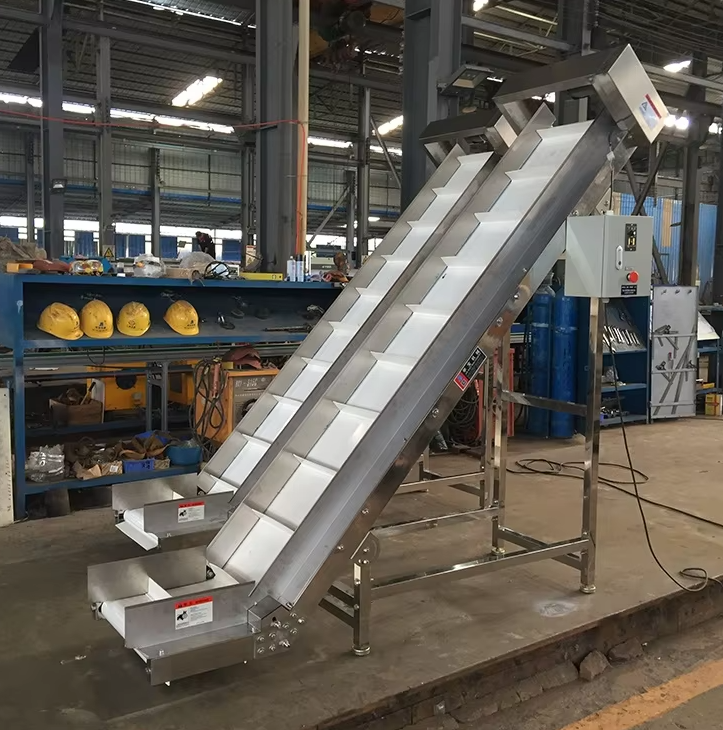
What are the advantages of an inclined belt conveyor?
With its unique structure and operating method, an inclined belt conveyor enables continuous conveying, high throughput, and wide adaptability, enabling long-distance and high-angle conveying. It also features a simple structure, stable operation, and easy maintenance. It offers significant advantages in the material conveying industry:
Space Saving: Inclined belt conveyors can lift materials vertically or at high angles, achieving the same lift height within a smaller footprint than horizontal conveyors. This is particularly important in factories with limited space or in production lines that span different levels, improving space utilization. High and Continuous Conveying Efficiency: Unlike intermittent conveying equipment (such as bucket elevators), belt conveyors enable continuous, uninterrupted material transport. This not only improves production efficiency but also reduces material backlogs and waiting time during conveying, making them particularly suitable for production lines requiring large-scale, continuous conveying.
Adaptable and Widely Applicable: By choosing from a variety of conveyor belt types (such as flat belts, patterned belts, and sidewall belts), inclined belt conveyors can accommodate a wide range of material conveying needs. Whether granular, lumpy, powdered, or bulk materials, as long as the material's angle of repose falls within the conveyor's inclination range, it can be conveyed.
Relatively Simple Maintenance and Stable Operation: Compared to other complex conveying equipment, the inclined belt conveyor has a relatively simple structure. Its primary maintenance tasks focus on belt tensioning and roller lubrication and cleaning. Furthermore, its smooth operation, low vibration and noise levels minimize disruption to the production environment. Easy to connect with other equipment: Inclined belt conveyors can seamlessly integrate with upstream feeding equipment (such as vibrating feeders) and downstream receiving equipment (such as screens and crushers) to form a complete automated production line. This flexibility makes them suitable for a variety of industrial processes.
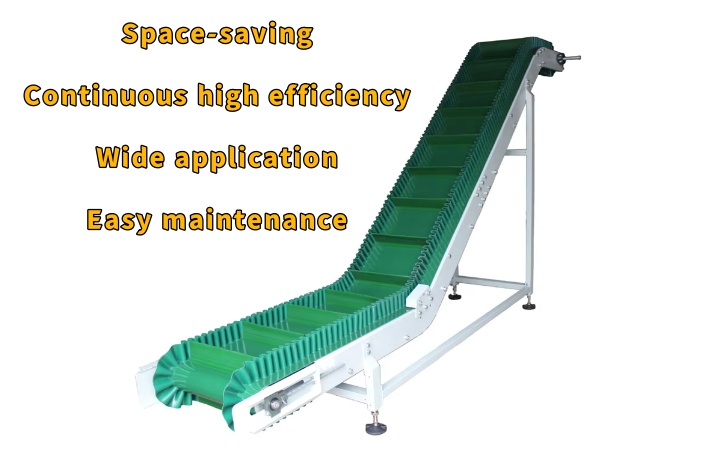
Inclined belt conveyor parameters
|
Belt width (mm) |
Conveying length(m) Power(kw) |
Conveying speed (m/s) |
Conveying amount (t/h) |
||
| B400 | ≤10 | 12-15 | 5-30 | 1.25-2.0 | 30-60 |
| 3 | 3-4 | 4-7.5 | |||
| B500 | ≤10 | 12-15 | 15-30 | 1.25-2.0 | 40-80 |
| 3 | 4-5.5 | 5.5-7.5 | |||
| B650 | ≤10 | 12-15 | 15-30 | 1.25-2.0 | 80-120 |
| 4 | 7.5 | 7.5-11 | |||
| B800 | ≤10 | 12-15 | 15-30 | 1.25-2.0 | 120-200 |
| 4 | 7.5 | 7.5-15 | |||
| B1000 | ≤10 | 10-20 | 20-40 | 1.25-2.0 | 200-320 |
| 5.5 | 7.5-11 | 11-22 | |||
| B1200 | ≤10 | 10-20 | 20-40 | 1.25-2.0 | 290-480 |
| 7.5 | 7.5-15 | 15-30 | |||
| B1400 | ≤10 | 10-20 | <20-40 | 1.25-2.0 | 400-680 |
| 11 | 15-22 | 22-45 | |||
| B1600 | ≤10 | 10-20 | <20-50 | 1.25-2.0 | 600-1080 |
| 15 | 22-30 | 30-75 | |||
| B1800 | ≤10 | 10-20 | <20-50 | 1.0-2.0 | 200-1500 |
| 18.5 | 30-45 | 45-110 | |||
| B2000 | ≤10 | 10-20 | <20-40 | 1.0-2.0 | 1000-2000 |
| 22 | 45-55 | 55-132 | |||
| B2400 | ≤10 | 10-20 | <20-40 | 1.0-2.0 | 1500-3000 |
| 30 | 55-75 | 75-185 | |||
What are the applications of inclined belt conveyors?
With their unique structure and flexibility, inclined belt conveyors play a vital role in material handling. They are widely used, primarily to overcome height differences, optimize spatial layout, and achieve continuous conveying and loading and unloading of bulk materials between different production stages. The following are their main application scenarios:
Vertical or high-angle material conveying: When materials need to be lifted from a lower level to a higher level, inclined belt conveyors can achieve this goal in a shorter path, effectively saving floor space. For example, in a material yard, they are used to transport materials from the ground to a stacker, or in a production line, they can lift semi-finished products to the next processing stage. Material transfer in space-constrained environments: In factories with limited space or complex structures, inclined belt conveyors can easily navigate obstacles and transport materials across floors and areas. Their compact design makes them ideal for connecting different production units, equipment, and storage areas.
Material lifting within process flows: Many industrial production processes require materials to be handled or mixed in layers. Inclined belt conveyors can effectively connect different process equipment. For example, in screening, crushing, and sorting, they can lift materials from one piece of equipment to another, ensuring continuity and automation of the production line.
Loading and unloading of bulk materials: Inclined belt conveyors excel in loading and unloading bulk materials. They can be used to load and unload bulk materials such as coal, ore, sand, and cement onto trucks, train cars, or ships, ensuring rapid material turnover.
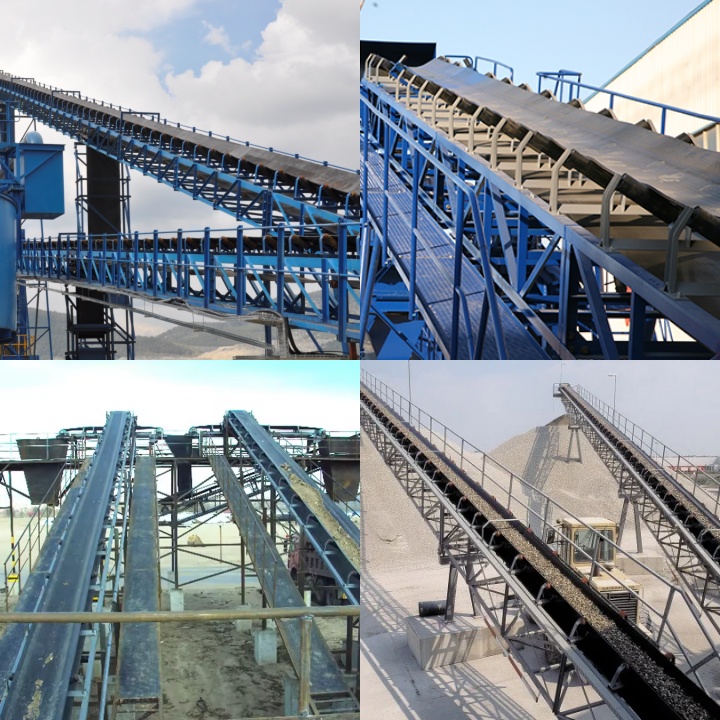
Inclined belt conveyor manufacturers
The core competitiveness of inclined belt conveyor manufacturers lies largely in their customization capabilities. Because conveying equipment requirements vary widely across industries, materials, and production environments, standardized products often fail to fully meet customer needs. Therefore, manufacturers often offer customization capabilities to meet individual needs. The first step in customization is precise adjustment of technical parameters. For example, manufacturers can adjust the conveyor's inclination angle and lift height based on the site layout and process requirements, ranging from gentle slopes to near-vertical angles to achieve a precise material conveying path. Conveyor belt types and widths are selected or designed based on different material characteristics (such as particle size, moisture content, and viscosity). For example, when conveying granular or powdery materials, patterned or sidewall belts are used; while larger, bulky materials may require wider, more wear-resistant conveyor belts. Regarding conveying speed and throughput, manufacturers can precisely calculate and adjust the conveyor's speed based on the customer's production cycle and processing capacity requirements, ensuring that the throughput matches the overall production line. Customization goes beyond parameter adjustment and extends further to the personalized design of the conveyor structure. For materials prone to generating dust, manufacturers can provide fully enclosed conveyors or add dust covers. For materials that are highly corrosive or abrasive, manufacturers may select special materials or apply surface treatments, such as stainless steel, wear-resistant steel plates, or special coatings, to extend the equipment's service life. Manufacturers can integrate different drive systems and electrical control solutions based on the customer's automation requirements, including variable frequency speed regulation, remote monitoring, and emergency stop protection, to enhance the equipment's intelligence and operational safety. In summary, the customization capabilities of inclined belt conveyor manufacturers are key to providing customers with safe and durable solutions. This demonstrates the manufacturer's ability to deeply understand and address the customer's conveying challenges in specific scenarios.
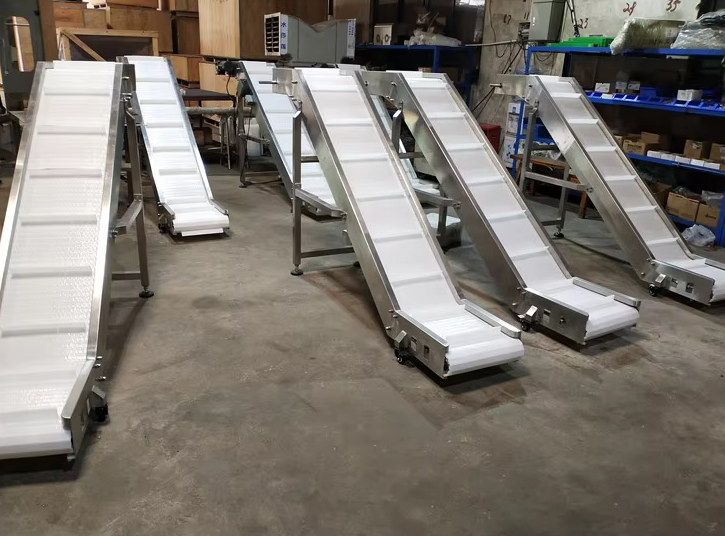
Inclined belt conveyors demonstrate unique application value in material conveying. They can lift materials to a high level with a small footprint, providing a solution for production environments with limited space or those that need to span varying elevations. By selecting conveyor belts of varying materials and structures, such as patterned belts and skirted belts, they can adapt to different material conveying requirements and effectively prevent material slippage or spillage. The equipment itself is relatively simple, consisting primarily of a frame, conveyor belt, rollers, drive unit, and tensioning device, making it easy to maintain and manage during daily operation.
